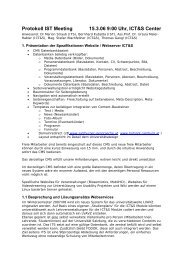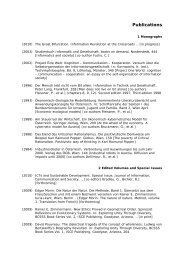ICTS AND SOCIETY: THE SALZBURG APPROACH - ICT&S
ICTS AND SOCIETY: THE SALZBURG APPROACH - ICT&S
ICTS AND SOCIETY: THE SALZBURG APPROACH - ICT&S
Create successful ePaper yourself
Turn your PDF publications into a flip-book with our unique Google optimized e-Paper software.
ICTs and Society: The Salzburg Approach<br />
careful deployment of wise, critical, and integrative assessment and design approaches.<br />
The Internet has to be the special target of such design practices as it is already<br />
the central digital platform where all modern ICTs are converging. In future this<br />
convergence process will only intensify further, especially with respect to the Web.<br />
Thus, the vision of a GSIS can only be achieved by carefully shaping the Net’s<br />
techno-social architecture according to the above mentioned values and aims. The<br />
Salzburg Approach’s way to think about this fundamental design process is to comprehend<br />
the Net as a technology for cooperation. In this regard, the notion of cooperation<br />
can be grasped as an abbreviation of the general GSIS-aims, but interpreted<br />
according to the special techno-social space of the Net.<br />
Fortunately, such a comprehension of the Net as a technology for cooperation<br />
does not have to be achieved from scratch. Quite contrary, the fundamental development<br />
and early usage of the Internet as well as later of the Web has been done<br />
in a basic social spirit of code-openness, cooperation, as well as free sharing of<br />
data, information, and knowledge. The following quotation from Tim Berners-Lee’s<br />
book “Weaving the Web”, where he tells the story of his invention of the Web’s basic<br />
architecture, gets this attitude to the point: “The web is more a social creation<br />
than a technical one. I designed it for a social effect – to help people work together<br />
– and not as technical toy. The ultimate goal of the Web is to support and<br />
improve our weblike existence in the world” (Berners-Lee 1999, 123).<br />
In fact, it can be easily asserted that the Web as we know it today could not have<br />
come into existence, if it would not have been designed as a decentralized, modular,<br />
and open architecture of participation based on open source in the first place.<br />
The same is, of course, true for the Internet as a whole, on which the Web rests<br />
upon. The Net is based on the visionary thoughts and design actions of the “wizards”<br />
of the early Internet in the tradition of J.C.R. Licklider, who laid the most basic<br />
architecture. This was done just as well in the prospect of enhancing human<br />
communication and cooperation via computational means, leading to network design<br />
solutions that would not inhibit the future development and prospering of this architecture<br />
(what ever might come in future).<br />
Hofkirchner | Fuchs | Raffl | Schafranek | Sandoval | Bichler 28









